WestLab Audio LABLIVE fifteen Subwoofer and LABRAT eight pro
author/photos: Christian Boche
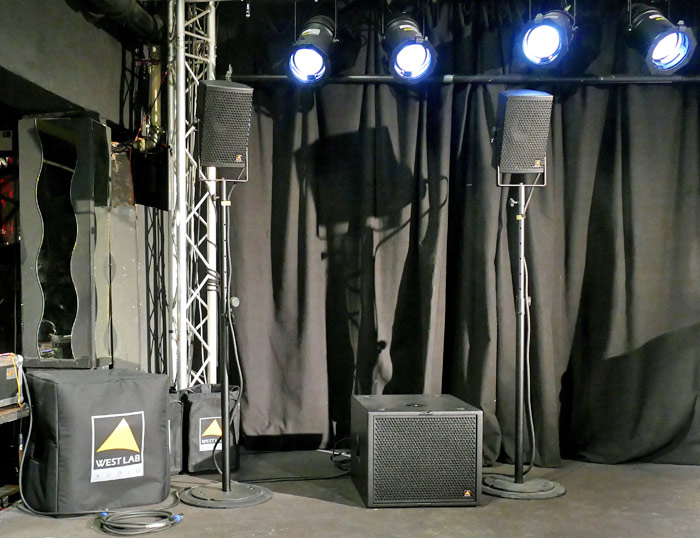
The image of German quality management suffered lastingly during the pandemic. The weakness in digitization is just one example of several topics, to work on. Who has to tear it out again? Sure, the German middle class. Companies are still working here whose quality standards and degree of digitization meet the highest standards. One example is the company WestLab-Audio from Schwerte. Located between the Ruhr area and the Sauerland, WestLab Audio develops and produces an extensive portfolio of professional sound reinforcement systems. I was able to convince myself of this when I personally picked up the test unit on site. Dietmar Bauer, Head of Marketing at WestLab Audio GmbH, took the time to present the modern production facilities and the in-house demo hall to me.
WestLab Audio's product range includes a wide range of different sound reinforcement tools, from a 3-inch broadband box to a full-blown double-eight line array. In addition, the guys from North Rhine-Westphalia have its own metal production in which, in addition to OEM products, the complete hardware for the WestLab audio portfolio is manufactured. And what about digitization?
Most WestLab Audio speakers are available in both active and passive versions. A specially developed four-channel amplifier (4 x 3kW) and a digital speaker controller with FIR filtering are available for the passive versions. In the smaller active series, amplifier modules with user DSP are used. As in our test system, which consists a "LABLIVE fifteen" subwoofer and two "LABRAT eight pro" tops.
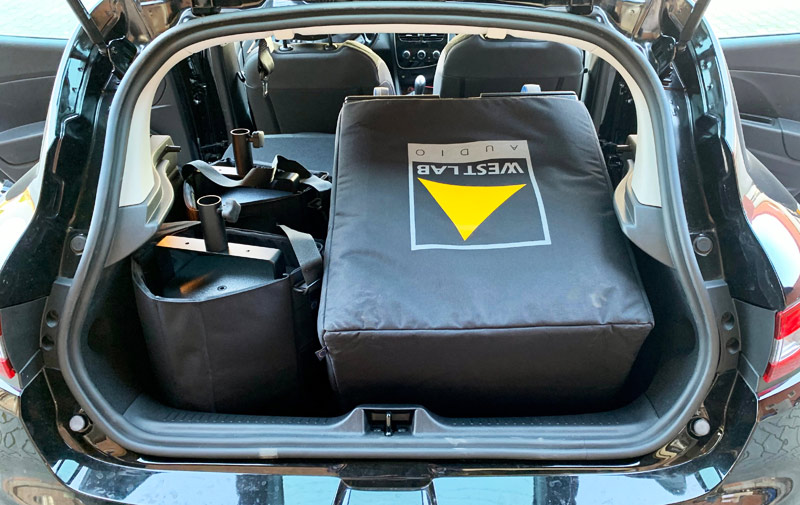
After a presentation in the demo room, my expectations are high when I go home with the test system. With the WestLab Audio test PA, I put a classic 2:1 satellite system into the trunk of a Renault Clios. In terms of "suitability for transport", the system has already received top marks. Let's take a closer look at the hardware and, like building a house, let´s start with the foundation.
LABLIVE fifteen Subwoofer
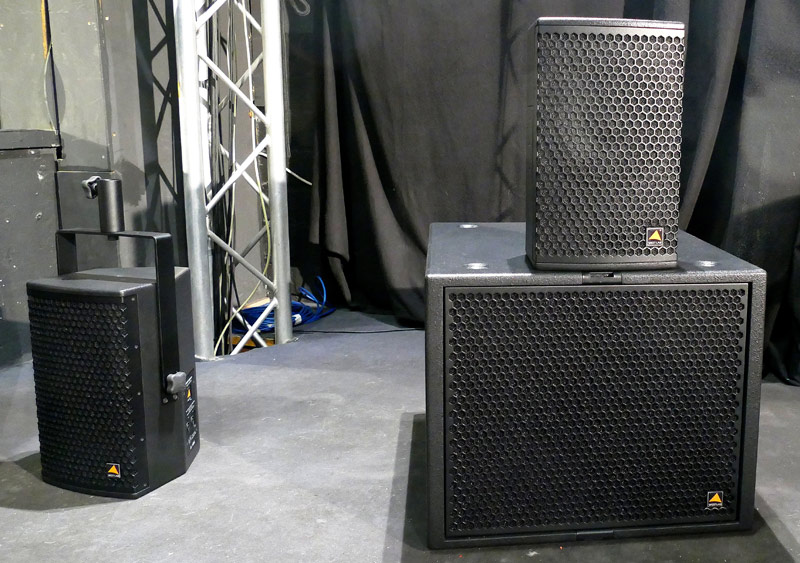
LABLIVE fifteen subwoofer is rock'n'roll in the literal sense of the word. Thanks to its removable roller board with 100mm Blue Wheels, its forty kilograms can be comfortably driven around. On the subwoofer there is still enough space available for the two tops, so that the set-up time for the entire system is pleasantly short. Let's take a look behind the loudspeaker grille. The compact bass reflex subwoofer is equipped with four triangular ports that guarantee a symmetrical radiation resistance load on the membrane. A 15 "high-end neodymium driver with a 4" voice coil from BMS is installed.
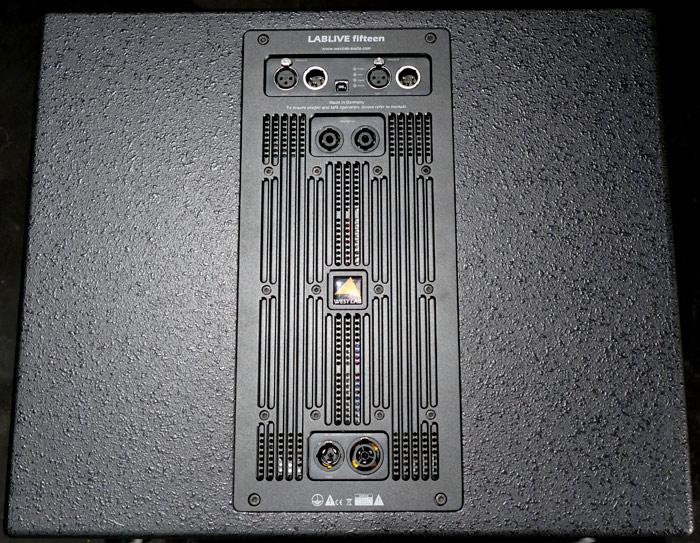
The whole system is driven by an active module which in addition to a user DSP contains three Class D power amplifier channels. The subwoofer is fired with 1,000 watts, while 500 watts are available for two passive tops. A Neutrik True1 fitting supplies the system with the necessary mains voltage. The True 1 plug can also be plugged in and unplugged under load, which is why the active module does not require a dedicated power switch.
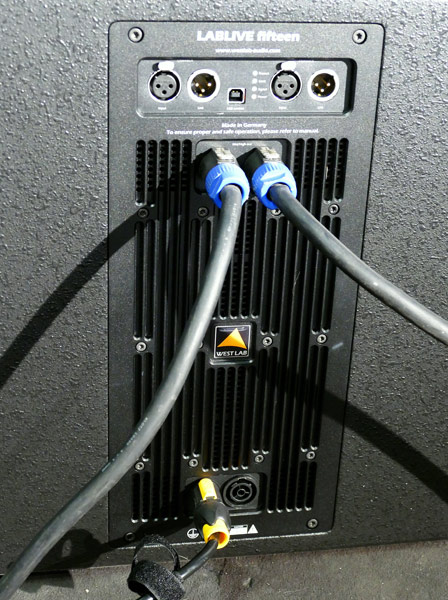
The user DSP with IIR filtering is already loaded with the data records for different WestLab Audio tops, which allows convenient plug-and-play. The housing is provided with black textured paint and is also equipped with a spacer rod holder with an M20 thread. With a maximum sound pressure of 132dB SPL peak, the LABLIVE fifteen should operate close to what is physically feasible.
LABRAT eight pro
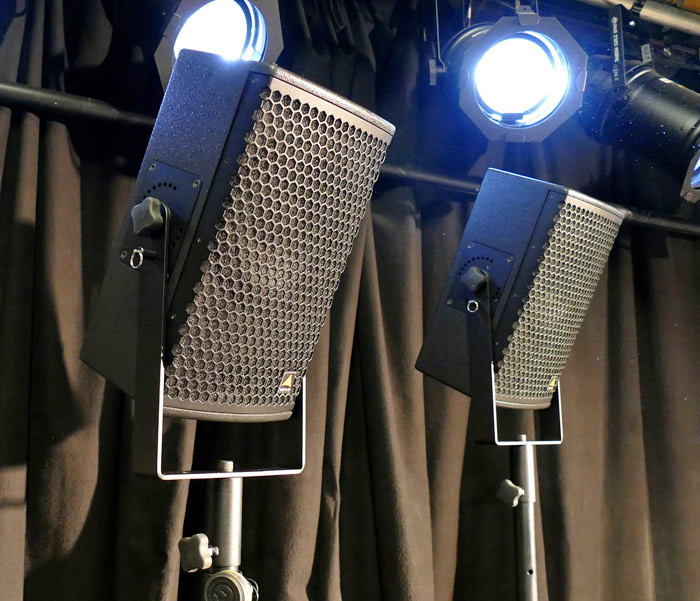
The preferred play partners of the LABLIVE fifteen subwoofer are the tops from the LABRAT series. Our test system is equipped with two LABRAT eight pro tops. The compact tops with 8 “coaxial drivers, as also the subwoofer, come in padded transport bags and sit on spacer rods via two U-brackets with integrated tripod mounts. The form factor of the LABRAT eight pro is very interesting. The housings have a bass reflex opening and a multifunctional housing with a slope for monitor useage.
As usual with WestLab Audio, the drivers are provided with a hexagonal loudspeaker grille with acoustic foam behind. This gives the boxes a modern, contemporary look. The workmanship of the housing and the paintwork corresponds to a professional level. Since WestLab Audio has its own metal department, they came up with something special regarding the U-bracket. The brackets can dock without the use of tools and are quickly and precisely aligned with the public area using an eighteen-position grid with a spring pin mechanism.
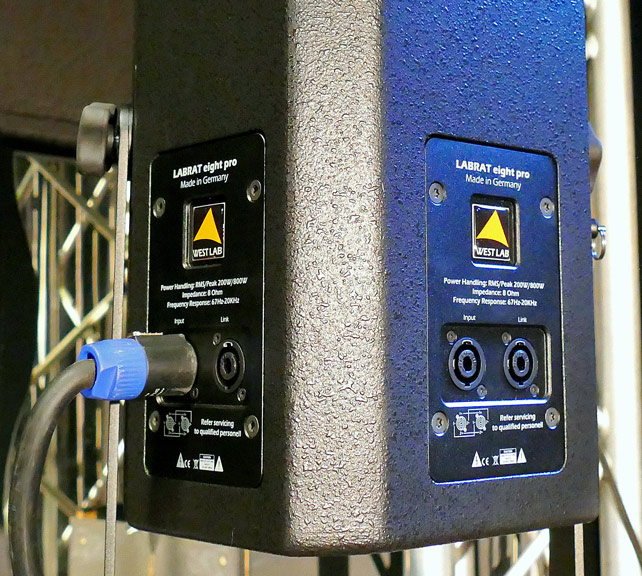
If you take a closer look at the back of the box, you should be surprised. WestLab Audio affords the luxury of giving the LABRAT eight pro two connection panels each with two Neutrik Speakon fittings. This allows the box to be positioned very flexibly, regardless of whether the LABRAT eight pro is used as a top, a monitor or as a side fill.
User DSP
The user DSP in the active module is addressed via the built-in USB interface. The DSP is an OEM product from the German manufacturer ALLDSP and has been specially adapted to the needs of WestLab Audio. The appropriate LABSOFT mini remote software can be downloaded free of charge from the WestLab Audio website and is available for both macOS and Windows users. The installation on my Windows 10, 64-bit laptop is done quickly. Anyone who would like to get an impression of the software without access to WestLab Audio products can use the implemented demo mode.
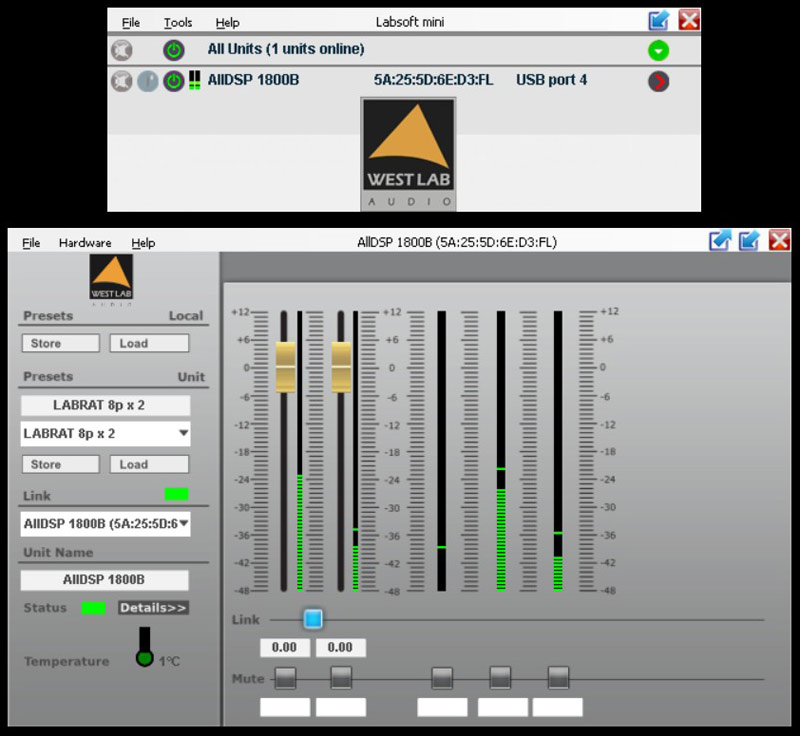
On the other hand, I can click directly on the “online” button of the LABSOFT mini software and after a few seconds I am connected to the DSP in the active module. The interface is structured simply and logically. Some functions and overview pages of the DSP are locked at the factory. The user can access the following functions, as shown in the picture. The storage and loading functions are located on the left in the interface. This allows the settings to be saved both in the hardware and on a computer.
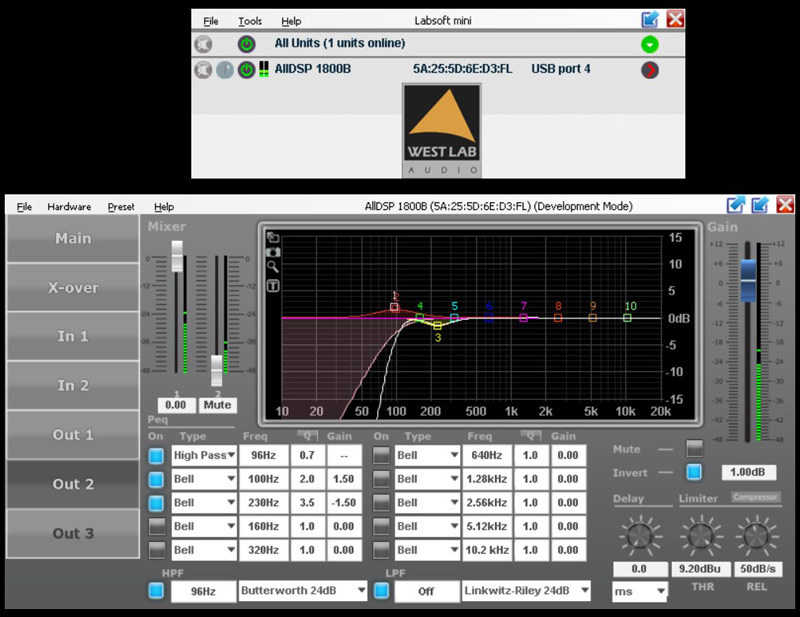
Presets already stored for other WestLab Audio tops ( LABRAT 6p, 8p and 12p) can be called up via a drop-down menu. The correct presetting is already loaded in the test position. The user can use the two virtual slide controls to continuously adjust the input volume. It is also possible to mute the two inputs and the three outputs if necessary.
The end customer does not have access to more profound functions, which takes into account the plug-and-play concept. The fact that the built-in DSP has significantly more options becomes apparent when I enter the developer password. This was made available to me for the test and gives me access to all settings. Out of respect for intellectual property, I do not want to go into any further detail. I would just like to put two extraordinary parameters in front of the practical test. On the one hand, only two EQ points are set in the entire system. Both points equalize the system with a very homeopathic dose of 1.5dB. This indicates that when developing the system, value was placed on the best possible selection of suitable drivers right from the start. An approach that is unfortunately becoming increasingly rare. The DSP is often misused to optimize a suboptimal driver selection with drastic DSP interventions. Obviously, WestLab Audio doesn't need that.
What I also noticed: The subwoofer is actually crossed over in the DSP at 28Hz. Without a highly resilient high-end chassis, something like this often ends with a defective driver in full load operation. So I'm very curious to see how the PA will perform in terms of sound.
Performance
The hearing test took place in a rock club on the left side of the Lower Rhine. The club offers space for 350 audience, has a professional acoustic concept and is therefore ideal for critical listening tests.
It starts with a medley from a player. The compact WestLab Audio PA behaves like a professional PA ideally should. Basically, it does not have its own sound, but simply projects what is offered to it as an input signal. In other words: first-class productions sound correspondingly impressive. On the other hand, any weak points are mercilessly exposed. Nothing remains hidden here. With a radiation characteristic of 90 x 90 degrees, the LABRAT eight pro covers the room widely. The 8 “coax drivers work as a point sound source without the support of a large tweeter, which creates a direct and at the same time relaxed basic sound.
Next, I load the system with a virtual soundcheck of a band I've been with for more than twenty years. I traditionally start with the bass drum and enjoy the rich depth of the 15“ subwoofer. This combines the depth of an 18" with the directness of a 15" and pushes a full level into the room. No question about it, the LABLIVE fifteen knows how to put the advantages of its first-class neodymium BMS driver in the limelight. I keep mixing and I notice that I need significantly less EQ support than with the in-house system. That accelerates the mix work sustainably.
Finally, I check the candidates with my voice and a Shure SM58. I set a low cut at 90 Hz and have no desire to equalize the microphone with further EQ points. For me, the result is more than consistent. In addition to the overall harmonic sound, the output of the system is lastingly impressive. Especially when you consider the compact dimensions of the WestLab Audio PA. Basically, the system sounds a size bigger than it actually is.
Essence
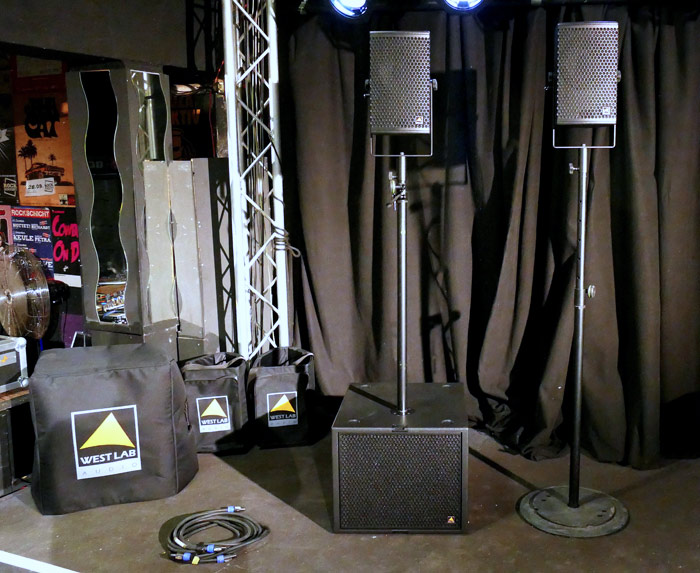
Many price differences in the pro audio world are simply justified. One example of this is the compact WestLab Audio test PA, consisting of a LABLIVE fifteen subwoofer and two LABRAT eight pro tops. The overall package is right on the spot. Top processing, good handling and a sound at the highest level.
In addition, the user can optionally add the following to the shopping cart: professional flight bars, padded protective covers and a braked roller board for the subwoofer, which promises a smooth ride to the venue. Equipped with a proven plug-and-play capability, the system is not only suitable for professional users such as rental companies or professional musicians. Rather, the investment is also worthwhile for musicians, DJs and smaller event locations with ambitious demands in terms of sound and handling. The two LABRAT eight pro tops in particular can be used particularly flexibly, so that the system can also be used without restriction for installations, monitor applications (drum or keyboard fill) and as a universal sound reinforcement solution.
Keyword “investment”: At first glance, the system is only a bargain to a limited extent. The three boxes add up to a list price of around 7,300 Euro. However, if you take the sound quality and the general performance into account, then you can say with a clear conscience that the tested PA is inexpensive, literally.
 How to resolve AdBlock issue?
How to resolve AdBlock issue?